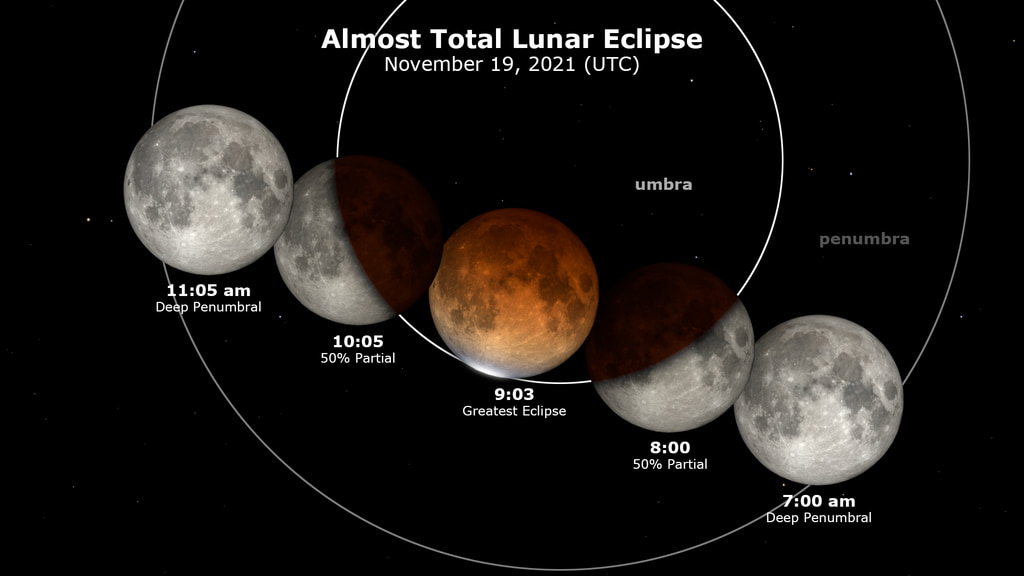Planets and Moons
ID: 4953
On November 19 (late evening of the 18th in some time zones), the Moon passes into the shadow of the Earth, creating a partial lunar eclipse so deep that it can reasonably be called almost total. At the moment of greatest eclipse, at around 9:03 a.m. Universal Time, 99.1% of the Moon's disk will be within the Earth's umbra. This part of the eclipse is visible in all of North America, as well as large parts of South America, Polynesia, eastern Australia, and northeastern Asia.
The penumbra is the part of the Earth's shadow where the Sun is only partially covered by the Earth. The umbra is where the Sun is completely hidden. The Moon's appearance isn't affected much by the penumbra. The real action begins when the Moon starts to disappear as it enters the umbra at about 7:20 a.m. UTC (2:20 Eastern Standard Time, 11:20 p.m. Pacific on the 18th). An hour or so after that, the part of the Moon still in sunlight will be small enough for observers' eyes to adapt to darkness and perceive the coppery color of the part of the Moon within the umbra. The animations here mimic this dark adaptation by increasing the apparent photographic exposure around the time of greatest eclipse.


November 19, 2021 Almost Total Lunar Eclipse
The penumbra is the part of the Earth's shadow where the Sun is only partially covered by the Earth. The umbra is where the Sun is completely hidden. The Moon's appearance isn't affected much by the penumbra. The real action begins when the Moon starts to disappear as it enters the umbra at about 7:20 a.m. UTC (2:20 Eastern Standard Time, 11:20 p.m. Pacific on the 18th). An hour or so after that, the part of the Moon still in sunlight will be small enough for observers' eyes to adapt to darkness and perceive the coppery color of the part of the Moon within the umbra. The animations here mimic this dark adaptation by increasing the apparent photographic exposure around the time of greatest eclipse.


Visualization Credits
Ernie Wright (USRA): Lead Visualizer
Laurence Schuler (ADNET Systems, Inc.): Technical Support
Ian Jones (ADNET Systems, Inc.): Technical Support
Laurence Schuler (ADNET Systems, Inc.): Technical Support
Ian Jones (ADNET Systems, Inc.): Technical Support
Please give credit for this item to:
NASA's Scientific Visualization Studio
NASA's Scientific Visualization Studio
Short URL to share this page:
https://svs.gsfc.nasa.gov/4953
Mission:
LRO (Lunar Reconnaissance Orbiter)
Data Used:
Note: While we identify the data sets used in these visualizations, we do not store any further details nor the data sets themselves on our site.
Keywords:
SVS >> HDTV
SVS >> Lunar
SVS >> Moon
SVS >> Hyperwall
SVS >> LRO
SVS >> Lunar Reconnaissance Orbiter
SVS >> Eclipse
SVS >> Lunar Eclipse
NASA Science >> Planets and Moons
https://svs.gsfc.nasa.gov/4953
Mission:
LRO (Lunar Reconnaissance Orbiter)
Data Used:
LRO/LOLA/Digital Elevation Map also referred to as: DEM
JPL DE421 also referred to as: DE421
Ephemeris - NASA/JPL
Planetary ephemerides
Lunar Reconnaissance Orbiter/LRO Camera/Natural Color Hapke Normalized WAC Mosaic also referred to as: LROC WAC Color Mosaic
Mosaic - Arizona State University
This natural-color global mosaic is based on the 'Hapke normalized' mosaic from LRO's wide-angle camera. The data has been gamma corrected, white balanced, and range adjusted to more closely match human vision.
Keywords:
SVS >> HDTV
SVS >> Lunar
SVS >> Moon
SVS >> Hyperwall
SVS >> LRO
SVS >> Lunar Reconnaissance Orbiter
SVS >> Eclipse
SVS >> Lunar Eclipse
NASA Science >> Planets and Moons











